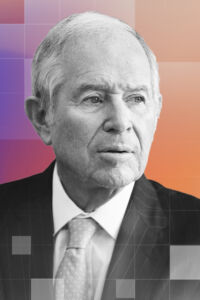Democratisation & Transparency: How alternative assets are readying for individual investors

Since their inception, private markets have been out of reach for most individual investors. The long-term time horizons, complexity, lack of liquidity and high fees, not to mention regulations aimed at protecting ordinary investors, has meant institutional investors have historically accounted for most of the capital raised for alternative funds.
This dynamic is rapidly changing. A need to diversify capital-raising efforts to a wider pool of investor types, coupled with a changing regulatory landscape and increased political will in some markets, have resulted in a positive outlook for those looking to tap the so-called ‘retail’ channels of capital at scale.

“I thought this should be something that should be a core part of people’s… investment portfolios,” Stephen Schwarzman, Blackstone’s chief executive, told Private Equity International in June, when asked about the trend of private equity coming downstream to ordinary investors. “If we can do that with the regular investor, then that’s super exciting.”
As we face the latter half of the decade, it is clear that any excitement related to what’s being referred to as the ‘democratisation’ of private markets – the trend of non-institutional investors, from wealthy individuals to ordinary ones, being able to invest in private markets asset classes – is justified. Non-institutional investors represent as much as $80 trillion in potential capital to be tapped, according to some estimates.
For an industry that is seeing flatlining annual fundraising figures in some asset classes, the allure of a new pot of capital is proving too hard to resist.
And yet, multiple headwinds exist, making this journey towards increasing democratisation not necessarily a straightforward one. For this second instalment of PEI Group’s Private Markets 2030 series, we conducted multiple conversations with senior and influential market participants to identify the key challenges over the next five years, and to reveal what they think the democratisation of private markets could look like by 2030.
Educating the masses
The importance of education stands out as a major trend. As private markets seek to raise capital via intermediaries, digital platforms or directly from ordinary individual investors, it is crucial that the end investor understands concepts such as the illiquid nature of private markets, or the concept of the J-curve.
Indeed, for everyday savers and investors, education about private markets needs to start at an even more basic level. A survey of US adults conducted in August by Harris Poll and the Wall Street Journal found that just 49 percent of respondents were familiar with the term “private equity funds”, compared with 82 percent for the term “stocks” and 73 percent for “bonds”. And only 10 percent said they were dissatisfied with their current 401(k) investment options and wanted more non-traditional options, the survey found.
For wealth investors, as a survey of 100 financial advisers last year by consultancy NextWealth found, concerns around liquidity and the perception that private markets are inherently risky are the two main barriers preventing greater take-up of private markets exposure among wealth clients.
“The biggest mistake that can happen is that the banks don’t inform their clients properly about the various asset classes the vehicle invests in, such as real estate, private equity or infrastructure,” Peter Beske Nielsen, partner and global head of private wealth and evergreen solutions at EQT, previously told Private Equity International.
The J-curve, described by one institutional LP as a “necessary evil in the private markets universe”, can be psychologically painful for even sophisticated institutional investors. An individual investor who doesn’t appreciate the nuances of how private markets operate could end up having a bad experience, leading to second-order problems.
Even evergreen products, which have seen enormous popularity among private wealth clients in recent years due to their perceived semi-liquid nature, are not without risk.
“When everyone wants their money back, they’ll want it all at the same time [because] there will have been some kind of market shock,” says a managing principal in charge of alternatives at a London-headquartered global bank. Redemption limits in evergreen funds, typically capped at 5 percent of net asset value per month or quarter, will mean not all redemption requests will be able to be honoured, the executive points out. “It’s a disaster waiting to happen.”
The cool factor
One of the trends underpinning the move towards opening up access to private equity is the rise of high-net-worth individuals (HNWIs), many of whom work with registered investment advisers.
RIAs and private equity managers may not always see eye to eye.
Steffen Meister, executive chairman of the board of directors at Partners Group, says ensuring that non-institutional capital is raised and managed in a responsible way will be one of the most important issues private markets investors face over the next five years.


“I think the challenge is that the [private markets] industry needs to approach democratisation in a sustainable way,” Meister says. A wealth manager may be tempted to meet its client’s request for exposure to the hot investment trend of the month, but such tactical approaches to private markets can be risky and won’t stand in for a portfolio management-orientated approach.
“There is a little bit of this natural instinct in wealth management to sell tactical programmes, something that’s cool, an investment trend that people read about in the newspapers one day and then see in an index or ETF the next. I just don’t think that quite works for private markets.” A diversified core programme acting as the largest private markets allocation in a portfolio is where an investor will find consistent benefits on a risk-return and diversification basis, he says.
“This is hard because that’s not necessarily how wealth management operates,” Meister adds. An RIA or wealth manager may be tempted to find a product to match their client’s thematic investment request, but there needs to be a real understanding of the risks and rewards of private markets, and how the various asset classes might fit in a portfolio.
Public-private partnerships and model portfolios
The last two years have seen a rise in alternatives managers partnering with traditional asset managers. Blackstone, KKR, Apollo Global Management, Goldman Sachs and Partners Group are among firms that have launched tie-ups with main street managers with the aim of creating products to serve both the US defined contribution market and the private wealth opportunity.
For the alts firms, they gain:
- access to distribution channels they otherwise might not be able to reach;
- benefit from expertise in certain sectors such as the DC pension markets; or
- public markets investment knowledge, among others.
For the traditional managers, they gain:
- access to the alternatives manager’s multiple private markets products;
- their returns and track record;
- brand recognition; and
- specialised knowledge.
Multiple market participants we spoke with for this report said they expect more such partnerships to be launched over the next few years. While there may be some industry consolidation – a theme Private Markets 2030 will explore later in this series – the unique investment philosophy of private markets firms means it’s probably unlikely they’ll acquire or agree to be acquired by traditional counterparts. But never say never.
At this stage, the specific products that will emerge from these joint ventures is unclear. Blackstone, which hasn’t disclosed specific details of how it will tap 401(k) capital at scale, said earlier in October that it has launched a business unit dedicated to the defined contribution space. The defined contribution business unit will sit within Blackstone’s existing private wealth business and will focus on broadening retirement savers’ access to private markets via DC pension plans.
One area that has seen steady progress is the use of evergreen vehicles to match non-institutional capital with private markets exposure.
In September, Hargreaves Lansdown, the UK’s largest investment platform, partnered with asset manager Schroders to offer clients access to two of the latter’s evergreen private markets funds. To Hargreaves, which boasts 1.9 million clients, structures such as the European Long-Term Investment Fund and the UK’s Long Term Asset Fund provide a “real opportunity” for investors to access an asset class that has predominantly been only available to institutional and high-net-worth clients, says Emma Wall, Hargreaves Lansdown’s chief investment strategist.
Ordinary investors being able to commit capital to productive finance and areas of the market that could help stimulate economic growth also presents a real opportunity, Wall says. “We think it’s the combination of diversified income and growth streams, and that productive finance element that makes private markets so interesting.”


Hargreaves is looking to partner with other private markets specialists to provide a wider range of alternatives for its clients, she adds.
BlackRock, which established a partnership with Partners Group last year, is banking on model portfolios becoming a major way that non-institutional investors will be able to access private markets. Managed model portfolios – a template that financial advisers can use to construct investment portfolios for their clients – could grow to become a $10 trillion market before the end of the decade, per BlackRock estimates. This year, the firm unveiled what it said was the first model portfolio that allows for private markets exposure and, importantly, facilitates rebalancing. The model is already available for use on third-party asset management platforms.
The model portfolio comprises 10-12 tickers, including exposure to two evergreen private markets vehicles, one for private equity and the other for private credit.
While BlackRock’s public-private model portfolio is limited to US retail investors and excludes institutions and 401(k) plans, differentiated models may follow, offering broader private markets access.
Still, supply has to match demand. In the private wealth space, a common question from clients is what role private markets can play in their portfolios, says Jon Diorio, head of alternatives for BlackRock’s US wealth business. Does a private wealth client who has made decent returns from a 60/40 equities and bonds portfolio over the last decade really need to add private markets to their portfolio?
“Our view is yes, because the last 10 years might not be exactly what the next 10 years are going to be,” Diorio says. “That’s probably the biggest education piece that we’re going over, which is [that] you’ve got to be forward-looking and understand where the markets are going.”
Technological disruption
Technology is another area expected to facilitate greater uptake by individual investors into private markets over the next five years. Advances in digital infrastructure are already making it easier for individual investors to gain exposure to private markets funds with lower minimum ticket sizes compared with those that institutional investors typically make to private markets funds. This year, Berlin-based savings platform Trade Republic, for example, said it would offer access to Apollo and EQT funds with a minimum investment amount of just €1 – an amount unthinkable several years ago.
Others see tokenisation – the use of blockchain technology to convert private equity holdings into tradable digital securities – as the next frontier in the democratisation of private markets due to the liquidity and smaller ticket sizes it can facilitate. As of mid-2025, firms including Apollo, KKR, Hamilton Lane and Partners Group had tokenised parts of their private markets funds.
Carlos Domingo – founder and chief executive of digital assets firm Securitize, which has partnered with multiple GPs to tokenise funds – reckons the shift from traditional closed-end fund structures to tokenised ones will follow a similar path to that of the advent of the personal computer.
“I believe, long term, we’ll shift from democratisation to digitalisation of the entire space,” Domingo says.
What lies ahead?
US president Donald Trump’s August executive order on opening up access to alternative investments in 401(k) plans represented a huge win for the private capital industry. It is clear that over the next five years, large alternatives managers will devote time and resources to how to tap this roughly $8.9 trillion market.
Despite the executive order, significant hurdles remain. Market sources point out that litigation risk remains a key barrier preventing target-date fund sponsors from adding private equity to their offerings. In 2025 alone, a pair of enforcement actions by the US Securities and Exchange Commission against two giants of the retail investment world – Vanguard Advisers and Empower Advisory Group – led to almost $26 million in fines. The cases were settled, but most importantly, they served as a warning to the private funds industry over navigating the complexities of managing retail capital.
The 401(k) opportunity is likely to play out at varying speeds across different asset classes. According to Ted Benedict, managing principal and consultant at Meketa, private real estate has had faster adoption in 401(k) plans compared with private equity due to its longer history of using open-end fund structures, which provide frequent liquidity windows.
It is worth noting that not everyone agrees that private markets coming downstream is a fait accompli. In September, members of the SEC’s investment advisory committee, in approving a suite of reform proposals that aim to bring more retail investors into private funds, said they hoped the world’s most powerful financial regulator would think about additional safeguards “given the potential adverse implications for retail investors who may have a significant percentage of their savings and retirement assets tied up in such products but [who] may need to access those funds due to planned or sudden life events”.
“There is a difference between investors losing money due to an affirmative choice to take excessive risk and a loss due to a failure to understand,” the committee noted.
Some have even argued that “democratisation” is not the most appropriate term to describe this trend. “Access [does not equal] empowerment,” Ludovic Phalippou, professor of financial economics at Oxford University’s Saïd Business School, wrote in a social media post in September. “Handing savers a high-fee, opaque, illiquid product sold with gameable metrics isn’t ‘democracy’; it’s marketing.”
For others, the mere advent of non-institutional capital entering private asset classes will bring positive change. Hines, a Houston-based developer-turned-real estate investment manager, reckons capital from private wealth channels could even account for half of its AUM within a few years.
“Private wealth… is growing maybe twice as fast as institutional capital, and it has relied on a 60/40 portfolio, fixed income and equities with almost nothing in alternatives,” David Steinbach, global chief investment officer at Hines, told PERE. The different cheque size and liquidity needs of private wealth investors will spur change, he added.
“You’ve got this new market entrant coming in force, and I think they will cause a lot of innovation to occur and some new ways of looking…That’s exciting to me.”




